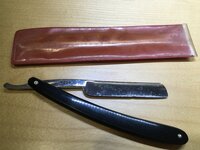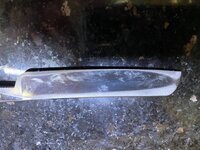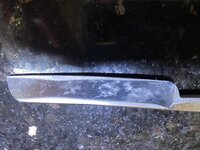OK first a warning - some of the below photos are stomach turning. I’m just a noob, try not to be too harsh!
I recently took a gamble on a Heljestrand 24 advertised on eBay. It clearly had been treated roughly, with a chip in the blade, but it was cheap, I had been looking for a Heljestrand, and I enjoy honing/restoration, so thought “why not?”
Honing down the chip went fairly smoothly at first, until I realized that the same trauma that had caused the chip had also warped the blade. I had only half a bevel on each side - one side had a bevel at the heel and toe, the other side only in the middle. I then spent some time trying to hone through this. The No24 is a near wedge (though to my eye it appeared close to a 1/4 hollow) so in theory if I brought the edge close enough to the spine eventually I would reach a point where the was metal on both sides of a straight line edge and then I would be OK. Better to do this on a 4/8 near wedge than a 7/8 extra hollow!
1st photo is the razor as received, next two photos show hone wear from the work I did this morning. Still don’t have a complete bevel on each side, but perhaps the finish line can be seen in the distance (or not). The chip is almost completely gone, but it is centered right at the point of maximum warp.
Looking for suggestions. My thought right now is that I have completely ruined the appearance of this razor, so I may as well keep honing - eventually I will have a straight edge with at least some bevel along the entire length of the blade. Am I correct that I am better off with a straight edge then trying to use a convex honing surface to follow the line of the warp?



I recently took a gamble on a Heljestrand 24 advertised on eBay. It clearly had been treated roughly, with a chip in the blade, but it was cheap, I had been looking for a Heljestrand, and I enjoy honing/restoration, so thought “why not?”
Honing down the chip went fairly smoothly at first, until I realized that the same trauma that had caused the chip had also warped the blade. I had only half a bevel on each side - one side had a bevel at the heel and toe, the other side only in the middle. I then spent some time trying to hone through this. The No24 is a near wedge (though to my eye it appeared close to a 1/4 hollow) so in theory if I brought the edge close enough to the spine eventually I would reach a point where the was metal on both sides of a straight line edge and then I would be OK. Better to do this on a 4/8 near wedge than a 7/8 extra hollow!
1st photo is the razor as received, next two photos show hone wear from the work I did this morning. Still don’t have a complete bevel on each side, but perhaps the finish line can be seen in the distance (or not). The chip is almost completely gone, but it is centered right at the point of maximum warp.
Looking for suggestions. My thought right now is that I have completely ruined the appearance of this razor, so I may as well keep honing - eventually I will have a straight edge with at least some bevel along the entire length of the blade. Am I correct that I am better off with a straight edge then trying to use a convex honing surface to follow the line of the warp?



